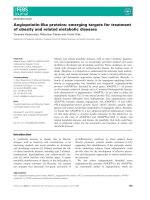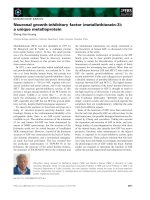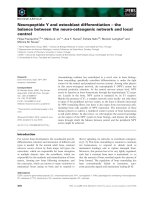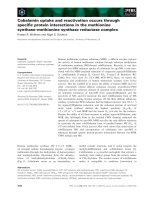Tài liệu Báo cáo khoa học: "Combining Functionality and Object Orientedness for Natural Language Processing" ppt
Bạn đang xem bản rút gọn của tài liệu. Xem và tải ngay bản đầy đủ của tài liệu tại đây (343 KB, 4 trang )
Combining Functionality and Ob]ec~Orientedness
for Natural Language Processing
Toyoakl Nishida I and Shuji Doshita
Department of Information Science, Kyoto University
Sakyo-ku, Kyoto 606, JAPAN
Abstract
This paper proposes a method for organizing linguistic
knowledge in both systematic and flexible fashion. We
introduce a purely applicative language (PAL) as an
intermediate representation and an object-oriented
computation mechanism for its interpretation. PAL enables
the establishment of a principled and well-constrained method
of interaction among lexicon-oriented linguistic modules. The
object-oriented computation mechanism provides a flexible
means of abstracting modules and sharing common knowledge.
1.
Introduction
The goal of this paper is to elaborate a domain-independent
way of organizing linguistic knowledge, as a step forwards a
cognitive processor consisting of two components: a linguistic
component and a memory component.
In this paper we assume the existence of the latter
component meeting the requirements described in [Schank 82].
Thus the memory component attempts to understand the
input in terms of its empirical knowledge, predict what
happens next, and reorganize its knowledge based on new
observations. Additionally, we assume that the memory
component can judge whether a given observation is plausible
or not, by consulting its empirical knowledge.
The role of the linguistic component, on the other hand, is
to supply "stimulus" to the memory component. More
specifically, the linguistic component attempts to determine
the propositional content, to supply missing constituents for
elliptical expressions, to resolve references, to identify the
focus, to infer the intention of the speaker, etc. In short, the
role of the [iguistic component is to "translate" the input into
an internal representation.
For example, the output of the linguistic component for an
input:
When did you go to New York?
is something like the following2:
There is an event e specified by a set of predicates:
isa(e)=going A past(e) A agent(e)=the_hearer A
destination(e)=New_York. The speaker is asking the
hearer for the time when an event e took place. The hearer
presupposes that the event e actually took place at some
time in the past.
1Currently visiting Department of Computer Science, Yale University,
New Haven, Connecticut 06520, USA.
If the presupposition contradicts what the memory component
knows, then the memory component will recognize the input as
a loaded question [Kaplan 82]. As a result, the memory
component may change its content or execute a plan to
informing the user that the input is inconsistent with what it
knows.
The primary concern of this paper is with the linguistic
component. The approach we take in this paper is to combine
the notion of eompositionality a and an object-oriented
computational mechanism to explore a principled and flexible
way of organizing linguistic knowledge.
2. Intermediate Representation and
Computational Device for
Interpretation
2.1 PAL (Purely
Applicative Language)
Effective use of intermediate representations is useful. We
propose the use of a language which we call PAL (Purely
Applicative Language).
In PAL, new composite expressions are constructed only
with a binary form of function application. Thus, if z and I/
are well-formed formulas of PAL, so is a form z(y).
Expressions of PAL are related to expressions of natural
language as follows:
Generally, when a phrase consists of its immediate
descendants, say z and y, a PAL expression for the phrase is
one of the following forms:
<z>( <V>)
or
<p>( <z>)
where ~a> stands for a PAL expression for a phrase ~*.
Which expression is the case depends on which phrase modifies
which. If a phrase z modifies V then the PAL expression for z
takes the functor position,
i.e.,
the form is ~z~(~y~).
Simple examples are:
big apple =* big~apple)
; adjectives modify .anne
very big ~ very(big)
; adverbs modify adjectives
very big apple ~ (very(big)Xapple)
; reeuesive composition
2As illustrated in this example, we assume a predicate notation a~ an
output of the linguistic component. But this choice is only for descriptive
purposes and is not significant.
awe
prefer the term *functionality" to "eompositionality", reflecting a
procedural view rather than a purely mathematicaJ view.
218
How about other cases? In principle, this work is based on
Montague's observations [Montague 74]. Thus we take the
position that noun phrases modify (are functions of, to be
more precise) verb phrases. But unlike Montague grammar we
do not use iambda expressions to bind case elements. Instead
we use special functors standing for case markers. For
example,
he runs ~ (*subject(he)Xruns)
he eats it ~ (*subject(he)X(*object(it)Xeats))
Another example, involving a determiner, is illustrated below:
a big apple ~ a(big(apple))
; determiners modlf~l nouns
Sometimes we assume "null" words or items corresponding
to morphemes, such as, role indicators, nominalizer, null NP,
etc.
apple which he eats
~ (which
((*subject(he))
((*object(*null))
(eats))))
(apple)
; restrictive relative clauses modif~ nouns,
; rdativizers modify sentences to make adjectives
In the discussion above, the notion of
modify
is crucial.
What do we mean when we say
z modifies
y? In the case of
Montague grammar, this question is answered based on a
predetermined set theoretical model. For example, a noun is
interpreted as a set of entities; the noun "penguin", for
instance, is interpreted as a set of all penguins. An adjective,
on the other hand, is interpreted as a function from sets of
entities to sets of entities; an adjective "small" is interpreted
as a selector function which takes such a set of entities
(interpretation of each noun) and picks up from it a set of
"small" entities. Note that this is a simplified discussion;
intension is neglected. Note also that different conception may
lead to a different definition of the relation
modifp,
which will
in turn lead to intermediate representations with different
function-argument relationships.
After all, the choice of semantic representation is relative to
the underlying model and how it is interpreted. A good choice
of a semantic representation - interpretation pair leads to a
less complicated system and makes it easier to realize.
The next section discusses a computational device for
interpreting PAL expressions.
2.2 Object-Oriented Domain
The notion of object-orientedness is widely used in computer
science. We employ the notion in LOOPS [Bobrow 81]. The
general idea is as follows:
We have a number of objects. Objects can be viewed as
both data and procedures. They are data in the sense that
they have a place (called a local variable) to store
information. At the same time, they are procedures in that
they can manipulate data. An object can only update local
variables belonging to itself. When data belongs to another
object, a message must be sent to request the update. A
message consista of a label and its value. In order to send a
message, the agent has to know the name of the receiver.
There is no other means for manipulating data. Objects
can be classified into classes and instances. A class defines
a procedure [called a method) for handling incoming
messages of its instances. A class inherits methods of its
superclasses.
Z. Interpretation of PAL Expressions in
Object-Oriented Domain
A class is defined for each constant of PAL. A class object
for a lexical item contains linguistic knowledge in a procedural
form. In other words, a class contains information as to how a
corresponding lexical item is mapped into memory structures.
A PAL expression is interpreted by evaluating the form
which results from replacing each constant of a given PAL
expression by an instance of an object whose class name is the
same as the label of the constant. The evaluation is done by
repeating the following cycle:
• an object in argument position sends to an object
in functor position a message whose label is
"argument ~ and whose value is the object itself.
• a corresponding method is invoked and an object is
returned as a result of application; usually one
object causes another object to modify its content
and the result is a modified version of either a
functor or an argument.
Note that objects can interact only in a constrained way. This
is a stronger claim than that allowing arbitrary
communication. The more principled and constrained way
modules of the linguistic component interact, the less
complicated will be the system and therefore the better
perspective we can obtain for writing a large grammar.
a.1 A Simple
Example
Let's start by seeing how our simple example for a sentence
"he runs" is interpreted in our framework. A PAL expression
for this sentence is:
(*subject(he)Xruus)
Class definitions for related objects are shown in figure 3.1.
The interpretation process goes as follows:
• lnstantiating '*subject': let's call the new instance
*subject 0.
• lnstantiating 'he': a referent is looked for from the
memory. The referent (let's call this i0) is set to
the local variable den, which stands for
'denotation'. Let the new instance be he 0.
• Evaluating '*subject0(he0)': a message whose label
is 'case' and whose value is 'subject' is sent to the
object he 0. As a result, he0's variable
case has a
value 'subject'. The value of the evaluation is a
modified version of he0, which we call he I to
indicate a different version.
• Iustantiating 'runs': let's call the new instance
runs 0. An event node (of the memory component)
is created and its reference (let's call this e0) is set
to the local variable
den.
Then a new proposition
'takes_place(e0)' is asserted to the memory
component.
219
class *subject:
argument:
scndImcssage ,
case:subject];
return[sc/j~.
; if a message with label 'argument' comes, this method will send to
the
object pointed to bll the variable rrtessage a message whose
label is 'ease' and whose value is 'subject '.
; a variable rrteasage holds the value of an incoming message and a
variable self points to the oSjeet itself.
class he:
if instantiated then
dcn*-'look
for referent'.
; when a new instance is created, the referent is looked for and
the
value is set to the local variable den.
ease:
ease*-messagc;
return[selJ].
; when a message comes whleh is labeled "ease', the local variable
ease
will be assigned the value the incoming message contains. The
value of this method is the object itself.
argument:
return[send[message, case:sol,l;
; when this instance is applied to another object, this object will send
a message whose label is the value of the local variable cone and
whose value field is the object itself. The value of
the message
processing is the value of this application.
class runs:
if instantiated then
den ereate['event:run'];
assert[takes_ place(den)].
; when a new instance of class '~ns" is instantiuted t a new ¢oent will
be
asserted to the memorf eornpanent. The referenee to the new
event is set to the local variable den.
subject:
assert['agent~den)~message.den']; return[sel~.
; when a message with label 'subject' comes, a new proposition is
asserted to the mernor~ component. 7he value of this message
handling is this obfeet itself.
Figure
3 1: Definitions of Sample Objects
3.3
Linking Case
Elements
One of the basic tasks of the linguistic component is to find
out which constituent is linked explicitly or implicitly to which
constituent. From the example shown in section 3.1, the
reader can see at least three possibilities:
Case linking by sending messages. Using conventional
terms of case grammar, we can say that "governer" receives a
message whose label is a surface ease and whose value is the
"dependant'. This implementation leads us to the notion of
abstraction to be discussed in section 3.4.
Lexleon-drlven methods of determining deep ease.
Surface case is converted into deep case by a method defined
for each governer. This makes it possible to handle this hard
problem without being concerned with how many different
meanings each function word has. Governers which have the
same characteristics in this respect can be grouped together as
a superclass. This enables to avoid duplication of knowledge
by means of hierarchy. The latter issue is discussed in section
3.2.
The use of implicit case markers. We call items such as
*subject or *object implicit, as they do not appear in the
surface form, as opposed to prepositions, which are explicit
(surface} markers. The introduction of implicit case marker
seems to be reasonable if we see a language like Japanese in
which surface case is explicitly indicated by postpositions.
Thus we can assign to the translation of our sample sentence a
PAL expression with the same structure as its English version:
KARE GA HASHIRU ~ (GA(KARE)XHASHIRU)
where, "KARE" means "he", "GA" postposition indicating
surface subject, "HASHIRU" "run ~, respectively.
• Evaluating hel(runs0): a message whose label is
'subject' and whose value is he ! is sent to runs0,
which causes a new proposition 'agent(e0) i 0, to
be asserted in the memory component. The final
result of the evaluation is a new version of the
object runs0, say runs 1.
The above discussion is overly simplified for the purpose of
explanation. The following sections discuss a number of other
issues.
3.2
Sharing Common
Knowledge
Object-oriented systems use the notion of hierarchy to share
common procedures. Lexical items with similar eharacterics
can be grouped together as a class; we may, for example, have
a class 'noun' as a superclass of lexicai items 'boy', 'girl',
'computer' and so forth. ~,Vhen a difference is recognized
among objects of a class, the class may be subdivided; we may
subcategorize a verb into static verbs, action verbs,
achievement verbs,
etc.
Common properties can be shared at
the supercla~s. This offers a flexible way for writing a large
grammar; one may start by defining both most general classes
and least general classes. The more observations are obtained,
the richer will be the class-superclass network. Additionally,
mechanisms for supporting a multiple hierarchy and for
borrowing a method are useful in coping with sophistication of
linguistic knowledge, e.g., introduction of more than one
subcategorization.
3.4
Abstraction
By attaching a sort of a message controller in front of an
object, we can have a new version of the object whose
linguistic knowledge is essentially the same as the original one
but whose input/output specification is different. As a typical
example we can show how a passivizer *en is dealt with. An
object *en can have an embedded object as a value of its local
variable
embedded.
If an instance of *en receives a message
with label '*subject', then it will send to the object pointed by
embedded
the message with its label replaced by '*object'; if it
receives a message with label 'by', then it will transfer the
message to the "embedded" object by replacing the label field
by '*subject'.
Thus the object *en coupled with a transitive verb can be
viewed as if they were a single intransitive verb. This offers
an abstracted way of handling linguistic objects.
The effect can be seen by tracing how a PAL expression:
( *subject(this(sentence)))
((by(a~computer)))
[*en{understand)))
"This sentence is understood by a computer."
is interpreted 4.
4Notice how the method for a transitive verb "understand" is defined, by
extending the definition for an intransitive verb ~run ~.
220
3.5 Impiieit Case Linklng
We can use a very similar mechanism to deal with case
linking by causative verbs. Consider the following sentence:
z wants It to do z.
This sentence implies that the subject of the infinitive is the
grammatical object of the main verb "wants ~. Such a
property can be shared by a number of other verbs such as
"allow ~, "cause ~, "leC, "make", etc. In the object-oriented
implementation, this can be handled by letting the object
defined for this class transfer a message from its subject to the
infinitive.
Note that the object for the these verbs must pass the
message from its subject to the infinitive when its grammatical
object is missing.
Another example of implicit case linking can be seen in
relative clauses. In an object-oriented implementation, a
relativizer transfers a message containing a pointer to the head
noun to a null NP occupying the gap in the relative clause.
Intermediate objects serve as re-transmitting nodes as in
computer networks.
3.6 Obligatory Case versus Non-Obligatory Case
In building a practical system, the problem of distinguishing
obligatory case and non-obligatory case is always controversial.
The notion of hierarchy is useful in dealing with this problem
in a "lazy" fashion. What we means by this is as follows:
In procedural approach, the distinction we make between
obligatory and non-obligatory cases seems to be based on
economical reason. To put this another way, we do not
want to let each lexical item have cases such as locative,
instrumental, temporal, etc. This would merely mean
useless duplication of knowledge. We can use the notion of
hierarchy to share methods for these cases. Any exceptional
method can be attached to lower level items.
For example, we can define a class "action verb" which has
methods for instrumental cases, while its superclass ~verb ~
may not.
This is useful for not only reflecting linguistic generalization
but also offering a grammar designer a flexible means for
designing a knowledge base.
4. A Few Remarks
As is often pointed out, there are a lot of relationships which
can be determined purely by examining linguistic structure.
For example, presupposition, intra-sentential reference, focus,
surface speech acts, etc. This eventually means that the
linguistic component itself is domain independent.
However, other issues such as, resolving ambiguity, resolving
task-dependent reference, filling task-dependent ellipsis, or
inferring the speaker's intention, cannot be solved solely by the
linguistic component [Sehank 80]. They require interaction
with the memory component. Thus the domain dependent
information must be stored in the memory component.
To go beyond the semantics-on-top-of-syntax paradigm, we
must allow rich interaction between the memory and linguistic
components. In particular, the memory component must be
able to predict a structure, to guide the parsing process, or to
give a low rating to a partial structure which is not plausible
based on the experience, while the linguistic component must
be able to explain what is going on and what it tries to see.
To do this, the notion of object-orientedness provides a fairly
flexible method of interaction.
Finally, we would like to mention how this framework
differs from the authors' previous work on machine
translation [Nishida 83], which could be viewed as an
instantiation of this framework. The difference is that in the
previous work, the notion of lambda binding is used for linking
cases. We directly used inteusional logic of Montague
grammar as an intermediate language. Though it brought
some advantages, this scheme caused a number of technical
problems. First, using lambda forms causes difficulty in
procedural interpretation. In the case of Montague grammar
this is not so, because the amount of computation doet not
cause any theoretical problem in a mathematical theory.
Second, though lambda expressions give an explicit form of
representing some linguistic relations, other relations remain
implicit. Some sort of additional mechanism should be
introduced to cope with those implicit relations. Such a
mechanism, however, may spoil the clarity or explicitness of
lambda forms. This paper has proposed an alternative to
address these problems.
Acknowledgements
We appreciate the useful comments made by Margot
Flowers and Lawrence Birnbanm of Yale University,
Department of Computer Science.
References
[Bobrow 81]
[Kaplan 82]
[Montague 74]
[Nishida 88]
[Schank 80]
[Schank 82]
Bobrow, D. G. and Stefik, M.
The LOOPS Manual.
Technical Report KB-VLS1-81-13, Xerox
PARC, 1981.
Kaplan, S. J.
Cooperative Responses from a Portable
Natural Language Query System.
Artificial Intelligence 19(1982) :165-187,
1982.
Montague, R.
Proper Treatment of Quantification in
Ordinary English.
In Thompson (editor), Formal Philosophy,
pages 247-270. Yale University, 1974.
Nishida, T.
Studies on the Application of Formal
Semantics to English-Japanese Machine
Tran elation.
Doctoral Thesis, Kyoto University, 1083.
Schank, R. C. and Birnbaum.
Memory, Meaning, and Syntax.
Technical Report 189, Yale University,
Department of Computer Science, 1980.
Sehank, R. C.
Dynamic Memory: A Theory of Reminding
and Learning in Computers and Peaple.
Cambridge University Press, 1982.
221









